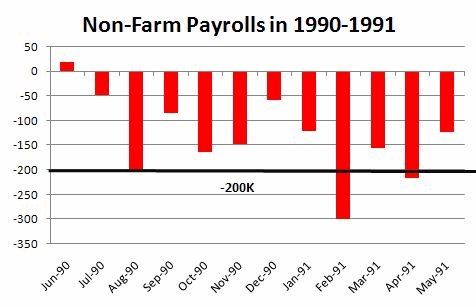The US economy has officially entered a recession and the labor market numbers that are due on Friday will confirm that. Not only do we expect the US economy to report its eleventh consecutive month of job losses, but the job losses will probably be the largest in 26 years.
The US economy has officially entered a recession and the labor market numbers that are due on Friday will confirm that. Not only do we expect the US economy to report its eleventh consecutive month of job losses but the job losses will probably be the largest in 26 years. In 2001, there was a single month job loss of 325k, but we expect the jobs lost in November to be more than the -343k decline that we saw back in July 1982. There will also be no capitulation bottom when it comes to the labor market, which means that even if non-farm payrolls drop by more than 350k, any bounce thereafter would only be a precursor to another major decline. A weak number would weigh heavily on the US dollar against the Japanese Yen and boost expectations for a 75bp rate cut by the Federal Reserve on December 16th.
How the Dollar May React to NFPs
Although the reaction in USD/JPY may be consistent with a weak number, the dollar’s performance against the Euro and British pound could be more erratic. If non-farm payrolls fall by more than -375k, it would be initially negative for the US dollar, but when the US stock market opens, we could see the dollar rally. Traders need to remember that the dollar is appreciating not because of the strength of the US economy, but because money flocks into low yielding currencies during a global recession. In a very short period of time, the US dollar has become the second lowest yielding G7 currency. A weak labor market number will mean two things – more weakness for US equities and the possibility of the Federal Reserve taking interest rates to zero. By extension, it will lead to weakness in USD/JPY, EUR/USD, GBP/USD and all of the Japanese Yen Crosses. The only way to avoid another round of selling would be if non-farm payrolls dropped by less than 300k.
Of the 70 analysts surveyed by Bloomberg, 9 expect Non-Farm Payrolls to drop by 400k or more. The most pessimistic is the Bank of Tokyo Mitsubishi who is calling for a mind boggling decline of 470k. The most optimistic is Landesbank in Berlin who is only calling for a decline of -220k.
Why Unemployment Could Hit a 15-Year High
All of the leading indicators for non-farm payrolls point to a very weak number. The employment component of service sector ISM, which is one of the strongest leading indicators for payrolls dropped to a record low. The same was true for the ADP private sector employment report which fell 250k – remember that ADP has historically undershot non-farm payrolls. Layoffs have jumped 148 percent, the 4 week average of jobless claims hit a 26 year high while consumer confidence plunged to a 28 year low. There is some good news though. Continuing claims have fallen, but unfortunately that was off of the highest level since December 1982. These numbers suggest that the unemployment rate could hit a 15 year high - it is currently at 6.5%, a 14-year high.
If the relationship shown in the following chart between non-farm payrolls and service sector ISM hold, then we would expect non-farm payrolls to drop 375k to 400k.
Here’s how the leading indicators for non-farm payrolls stack up:
1. Employment Component of Service Sector ISM Dropped to Lowest Level on Record
2. Employment Component of Manufacturing Sector ISM Falls to 34.2, a Record Low
3. ADP Report Private Sector Job Losses at 250,000, Record Low
4. Challenger Layoffs Skyrocket 148%, Highest Since January 2002
5. University of Michigan Consumer Confidence Index Hits 28 Year Low
6. 4 Week Average Claims Reaches Highest Level in 26 Years
7. Monster.com Index Drops 7 Points, Down 22% YoY
8. Continuing Claims Shows 109K Increase
Large Job Losses to Continue Beyond November
Don’t expect the job losses to end in November either. More layoffs have been announced this past week by companies like JPMorgan and AT&T. The current recession is the closest to the 1980s recession, when job losses continued for 17 consecutive months. Even the recession in 2001, which was shallower than the current recession had 15 consecutive months of job losses. Therefore non-farm payrolls should continue to remain negative into the first half of 2009. Furthermore, a large drop in non-farm payrolls does not mean that we have hit a bottom.
In analyzing non-farm payrolls data during past recessions, we see that at the beginning of an official recession, as defined by the National Bureau of Economic Research, non-farm payrolls start to decline rapidly. However after falling between 200k and 300k, job cuts stall and then pick up once again. We saw this trend in the 1981 to 1982 recession, the 1990 to 1991 recession and during the 2001 recession. It should happen again in 2009.
The following chart illustrates the double dip trend of non-farm payrolls during the 2001 and recession. 
Here are the charts for 1991 and 1981 

Kathy Lien is Director of Currency Research at GFT, and runs KathyLien.com.